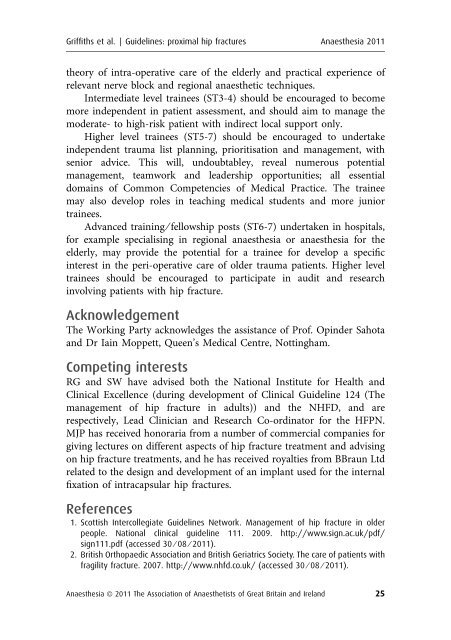Management of Proximal Femoral Fractures 2011 - aagbi
Management of Proximal Femoral Fractures 2011 - aagbi
Management of Proximal Femoral Fractures 2011 - aagbi
Create successful ePaper yourself
Turn your PDF publications into a flip-book with our unique Google optimized e-Paper software.
Griffiths et al. | Guidelines: proximal hip fractures Anaesthesia <strong>2011</strong>theory <strong>of</strong> intra-operative care <strong>of</strong> the elderly and practical experience <strong>of</strong>relevant nerve block and regional anaesthetic techniques.Intermediate level trainees (ST3-4) should be encouraged to becomemore independent in patient assessment, and should aim to manage themoderate- to high-risk patient with indirect local support only.Higher level trainees (ST5-7) should be encouraged to undertakeindependent trauma list planning, prioritisation and management, withsenior advice. This will, undoubtabley, reveal numerous potentialmanagement, teamwork and leadership opportunities; all essentialdomains <strong>of</strong> Common Competencies <strong>of</strong> Medical Practice. The traineemay also develop roles in teaching medical students and more juniortrainees.Advanced training ⁄ fellowship posts (ST6-7) undertaken in hospitals,for example specialising in regional anaesthesia or anaesthesia for theelderly, may provide the potential for a trainee for develop a specificinterest in the peri-operative care <strong>of</strong> older trauma patients. Higher leveltrainees should be encouraged to participate in audit and researchinvolving patients with hip fracture.AcknowledgementThe Working Party acknowledges the assistance <strong>of</strong> Pr<strong>of</strong>. Opinder Sahotaand Dr Iain Moppett, Queen’s Medical Centre, Nottingham.Competing interestsRG and SW have advised both the National Institute for Health andClinical Excellence (during development <strong>of</strong> Clinical Guideline 124 (Themanagement <strong>of</strong> hip fracture in adults)) and the NHFD, and arerespectively, Lead Clinician and Research Co-ordinator for the HFPN.MJP has received honoraria from a number <strong>of</strong> commercial companies forgiving lectures on different aspects <strong>of</strong> hip fracture treatment and advisingon hip fracture treatments, and he has received royalties from BBraun Ltdrelated to the design and development <strong>of</strong> an implant used for the internalfixation <strong>of</strong> intracapsular hip fractures.References1. Scottish Intercollegiate Guidelines Network. <strong>Management</strong> <strong>of</strong> hip fracture in olderpeople. National clinical guideline 111. 2009. http://www.sign.ac.uk/pdf/sign111.pdf (accessed 30 ⁄ 08 ⁄ <strong>2011</strong>).2. British Orthopaedic Association and British Geriatrics Society. The care <strong>of</strong> patients withfragility fracture. 2007. http://www.nhfd.co.uk/ (accessed 30 ⁄ 08 ⁄ <strong>2011</strong>).Anaesthesia ª <strong>2011</strong> The Association <strong>of</strong> Anaesthetists <strong>of</strong> Great Britain and Ireland 25
















